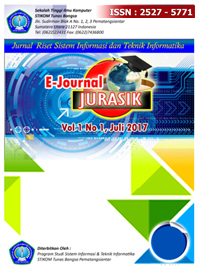Implementasi Algoritma Clustering K-Means Untuk Mengelompokkan Mahasiswa Baru Yang Berpotensi (Studi Kasus: STMIK Budi Darma)
Abstract
Full Text:
PDFReferences
J. O. Ong, “Implementasi Algotritma K-means clustering untuk menentukan strategi marketing president university,” J. Ilm. Tek. Ind., vol. vol.12, no, no. juni, pp. 10–20, 2013.
J. C. Rubio-romero et al., “Data Mining Menggunakan Algoritma K-Means Clustering Untuk Menentukan Strategi Promosi,” Ind. Mark. Manag., vol. 1, no. 1, pp. 1–9, 2014.
E. Buulolo, “Implementasi Algoritma Apriori Pada Sistem Persediaan Obat ( Studi Kasus : Apotik Rumah Sakit Estomihi Medan ),” Pelita Inform. Budi Dharma, vol. 4, no. Agustus 2013, pp. 71–83, 2013.
E. Buulolo, N. Silalahi, Fadlina, and R. Rahim, “C4.5 Algorithm To Predict the Impact of the Earthquake,” Int. J. Eng. Res. Technol., vol. 6, no. 2, pp. 10–15, 2017.
H. Aprilianto and E. Ramadhani, “Implementasi Metode K-Means Clustering untuk Pengelompokan Lulusan STMIK-Banjarbaru Berdasarkan Kompetensi,” Progresif, vol. 9, No.1, no. ISSN: 0216-3284, 2013.
F. Nasari and S. Darma, “PENERAPAN K-MEANS CLUSTERING PADA DATA PENERIMAAN MAHASISWA BARU,” in Seminar Nasional Teknologi Informasi dan Multimedia 2015, 2015, pp. 6–8.
DOI: http://dx.doi.org/10.30645/senaris.v1i0.3
Refbacks
- There are currently no refbacks.
 








